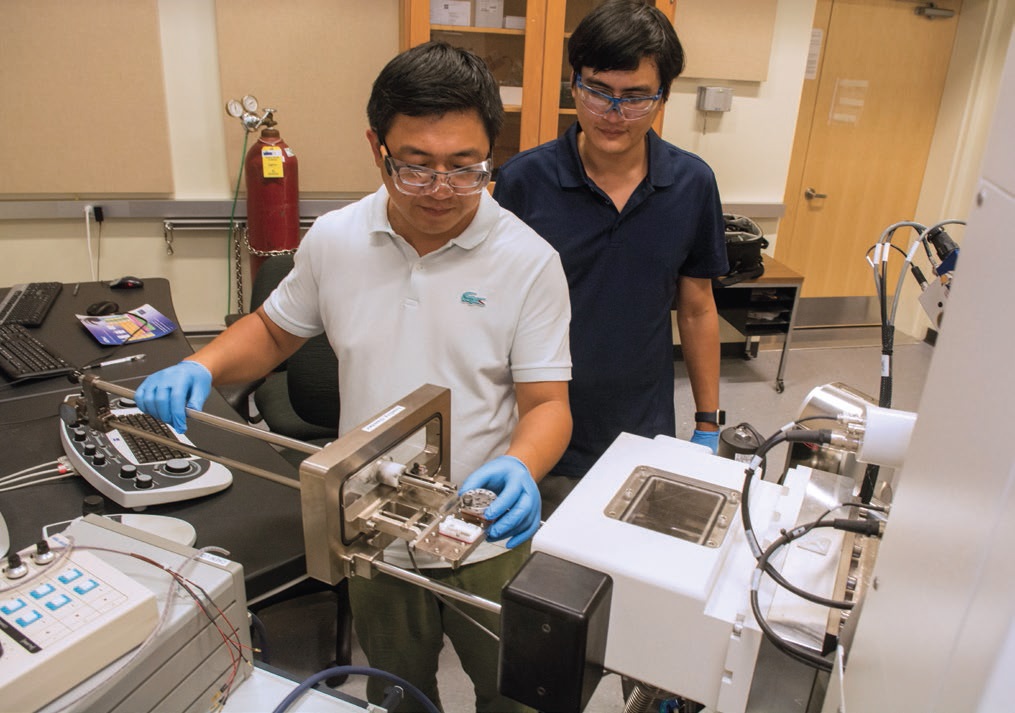More durable and cost-effective fuel cell
Dr. Neil Canter, Contributing Editor | TLT Tech Beat December 2017
A new approach produces fuel cells that are more durable and less expensive.
KEY CONCEPTS
•
Modification of the proton exchange membrane with tungsten carbide nanoparticles produced a more durable fuel cell.
•
At 5% relative humidity, the tungsten carbide-based membrane increased fuel cell performance by 80%.
•
Tungsten carbide nanoparticles bind radicals more effectively than currently available fuel cells leading to improved durability.
INTEREST IN USING FUEL CELLS TO POWER AUTOMOBILES continues to grow as several OEMs are offering this technology commercially. The appealing feature of fuel cells is that concerns about emissions are eliminated as water is produced as the only byproduct along with energy from the reaction of hydrogen and oxygen.
The most promising fuel cell uses a proton exchange membrane based on copolymers of perfluorosulfonic acid and polytetrafluoroethylene. A platinum catalyst located at both electrodes is used to facilitate the reaction between hydrogen and oxygen.
Dr. Liang Wang, associate scientist in the Center for Fuel Cell Research (CFCR) in the department of mechanical engineering at the University of Delaware in Newark, Del., says, “Commercialization of fuel cells is limited because of two key factors. The cost of the fuel cell car is much more expensive than an automobile powered by an internal combustion engine because of the need to use the precious metal, platinum, as the catalyst.”
Wang continues, “A second factor hindering fuel cells is the durability of the catalyst and the proton exchange membrane. The U.S. government requires fuel cells to last for 5,000 hours before needing to be replaced. This is equivalent to 150,000 miles of driving (over 240,000 kilometers). At present, the durability of the current fuel cell is approximately 3,900 hours.”
Wang points out that the U.S. government will be increasing the durability target for fuel cells to 8,000 hours in the future. A previous TLT article discussed work by researchers to improve the performance of high-temperature fuel cells based on phosphoric acid doped polybenzimidazole (
1). A quaternary ammonium biphosphate ion-pair-coordinated polymer fuel cell was developed that is at least three time more durable.
Currently used proton exchange membrane-based fuel cells also are ineffective under low humidity conditions. Two approaches to overcome this problem included adding hydrophilic materials to the membrane that will retain water and adding platinum nanoparticles directly to the membrane. The use of additional platinum improves performance but unfortunately adds to the cost of the fuel cell.
An alternative approach to producing fuel cells that are more durable and less expensive is needed to facilitate their continuing use in automobiles. Such an approach has been developed.
TUNGSTEN CARBIDE
Wang, in collaboration with Weiqing Zheng, a research associate at the Catalytic Center for Energy Innovation, and other co-workers at the University of Delaware, modified the existing proton exchange membrane by dispersing tungsten carbide nanoparticles in the perfluorosulfonic acid, polytetrafluoroethylene copolymer matrix to produce a membrane for fuel cells that is more durable and more cost effective.
Wang says, “Our approach was to develop a self-hydrating membrane that will enable hydrogen and oxygen moving through the membrane to react. We found that tungsten carbide exhibits similar catalytic properties to platinum and demonstrated that this material—when properly dispersed in the proton exchange membrane—improved the durability and performance of the fuel cell and also reduced the cost.”
Tungsten carbide nanoparticles were prepared through temperature-programmed reduction–carburization followed by hydrothermal carbonization. The resulting tungsten carbide nanoparticles exhibited diameters between three and five nanometers and were well dispersed on the surface of the carbon sphere.
An analysis of the tungsten carbide-based proton exchange membrane was conducted using dual beamed scanning electron microscopy. Evaluation of the tungsten carbide nanoparticle-based membrane compared to a standard proton exchange membrane, a membrane containing platinum black catalyst and a membrane containing commercially available tungsten carbide particle with diameters of approximately 55 nanometers, was conducted using a standard U.S. Department of Energy procedure.
Wang says, “All of the catalysts were applied at a 5% concentration by weight because this is the optimum concentration to achieve the best self-hydration performance. Too high of a catalyst concentration will lead to a decrease in the hydrogen ion conductivity of the membrane while too low of a concentration will not allow the membrane to generate enough water.”
Performance testing showed that the tungsten carbide nanoparticle-based membrane increased the performance of the fuel cell by 80% at 5% relative humidity compared to currently used fuel cell membrane. In durability testing, conducted at 90 C and 35% relative humidity, no decline in performance was seen with the tungsten carbide nanoparticle-based membrane after 100 hours of operation. The performance of all of the other membranes declined over time.
Focused ion beam, scanning electron microscopy (
see Figure 2) indicated that the tungsten carbide nanoparticles did not damage the membrane and enhanced performance. In a similar analysis of the platinum black catalyst-based membrane, defects were detected that caused severe damage to the membrane.
 Figure 2. Analysis of the tungsten carbide modified proton exchange membrane was conducted in part with focused ion beam, scanning electron microscopy. (Figure courtesy of the University of Delaware.)
Figure 2. Analysis of the tungsten carbide modified proton exchange membrane was conducted in part with focused ion beam, scanning electron microscopy. (Figure courtesy of the University of Delaware.)
One added problem in retarding fuel cell durability is the formation of hydroxyl and hydrogen radicals from the platinum electrodes, which can destabilize the membrane by reacting with sulfonate groups attached to the polymer backbone. The researchers determined through theoretical calculations that tungsten carbide nanoparticles bind these radicals more effectively than platinum leading to improved fuel cell durability.
Wang says, “The tungsten carbide catalyst reduces the burden of the system by enabling the fuel cell to operate more effectively under low humidity conditions. We also believe that fuel cell performance is enhanced because the tungsten carbide reacts more efficiently with free radicals that can chemically degrade the membrane.”
The researchers hope that the tungsten carbide-based fuel cell membrane will be of interest to the automotive industry due to the promising results demonstrated in this research. Additional information can be found in a recent article (
2) or by contacting Wang at
lwangx@udel.edu.
REFERENCES
1.
Canter, N. (2016), “New polymer-based fuel cell,” TLT,
72 (11), pp. 14-15.
2.
Zheng, W., Wang, L., Deng, F., Giles, S., Prasad, A., Advani, S., Yan, Y. and Vlachos, D. (2017), “Durable and self-hydrating tungsten carbide-based composite polymer electrolyte membrane fuel cells,”
Nature Communications,
8, Article Number: 418, DOI: 10.1038/s41467-017-00507-6.
 Neil Canter heads his own consulting company, Chemical Solutions, in Willow Grove, Pa. Ideas for Tech Beat can be submitted to him at neilcanter@comcast.net
Neil Canter heads his own consulting company, Chemical Solutions, in Willow Grove, Pa. Ideas for Tech Beat can be submitted to him at neilcanter@comcast.net.